2,000 years ago, Libra symbolized the autumnal equinox and had a practical meaning - it marked the time for peasants to sow their winter crops. They were therefore very important for life. The sign of Libra and the autumnal equinox are currently located in Virgo, where the precession of the Earth's axis has shifted them. The Sun currently passes through Libra from October 31 to November 22. The brightest stars of the constellation form a pattern of an irregular quadrilateral south of the celestial equator, lying symmetrically with respect to the ecliptic between Virgo and Scorpio. Libra lies outside the Milky Way, so it does not contain open star clusters and diffuse nebulae, but rather quite a few faint galaxies. There are also a few attractive binaries and one very loose Class XI globular cluster.
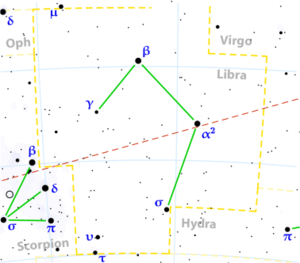
Zubenelschemali (β Lib) - "The Northern Tap" is slightly brighter (2.61 mag) and has a peculiar greenish tint, which is somewhat unusual. The star is approximately 100 times more luminous than the Sun.
Zubenelgenubi (α Lib) - The name means "southern clapper" and refers to the origin of the constellation. It is a very easily distinguishable binary star that can be observed with a small telescope. The primary component has a magnitude of 2.75 and is separated by 231" from the companion with a magnitude of 5.8. In terms of classification, it is a bright wide pair consisting of a white and yellow component. Since both stars exhibit the same proper motion, they are likely a physical binary. Its distance from Earth is 75 light-years.
τ Lib - The pair of stars with magnitudes 4.7 and 9.7 is separated by 8.5", so we can distinguish them with a telescope of at least 6 cm. The system is located 367 light-years away from Earth.
ι Lib - A complex multiple star, which appears as a single star with a brightness of 4.2 mag when observed with the naked eye. The finder will show its companion labeled as 25 Librae. A telescope with an objective diameter over 80 mm will reveal that the primary star has a faint companion of 9 mag at a separation of 58". With a larger telescope and appropriate magnification, it should eventually be proven that it itself is a close binary star. Its faint companion of 11 mag is located at a separation of 1.9" from it.
δ Lib - An eclipsing variable star similar to Algol has a period of 2.32 days and its brightness ranges from 4.92 to 5.9 magnitude. The entire cycle of brightness changes can be observed with the naked eye. The change from maximum to minimum occurs in about 6 hours, which can be noticed in a single spring night. Among the main minima, there is one insignificant secondary minimum, which only reaches a tenth of the stellar magnitude, making it difficult to perceive. The system is located nearly 300 light-years away from Earth.
μ Lib - In a good 100 mm refractor, we will see the binary star as a close pair of white stars, like two disks in contact (1.8 "). We will be able to distinguish them completely under calm atmospheric conditions. The components have magnitudes of 5.8 and 6.7.
NGC 5897
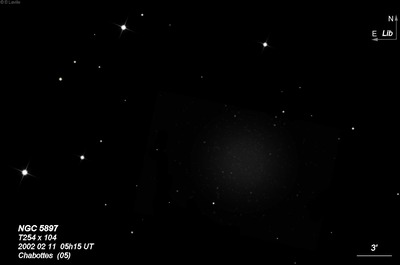
12x80 (6/30/84): very faint but visible in the finder!
William Herschel discovered NGC 5897 = H VI-19 = H VI-8 = h3596 on 25 Apr 1785 (sweep 209) and recorded VI-8 as "a very close compressed cluster of stars, 8 or 9' in diameter, extr rich, of an iR figure, a little E. The stars so small as hardly to be visible so accumulated in the middle as to look nebulous." There is nothing at his position and Dreyer chronicled the problems in the sweep in his 1912 "Scientific Papers of William Herschel".
Harold Corwin has an extensive discussion and argument that H VI-8 = NGC 5897. WH rediscovered this cluster a couple of weeks later on 10 Mar 1785 (sweep 383) and recorded VI-19 as "A beautiful L cluster of the most minute and most compressed stars imaginable. Different sizes and a faint red colour perceivable." His position on this sweep was only 3' south of center.
In 1914, Hardcastle classified NGC 5897 as a known spiral nebula (based on ?). The following year, Knox-Shaw reported it was a loose globular cluster and "certainly no a spiral nebula", based on a photograph taken between 1912-14 at the Helwan Observatory with the Reynolds reflector.
300/350mm - 13.1" (6/30/84): about two dozen faint stars resolved over irregular haze.
13.1" (6/19/82): a number of faint stars resolved over a larger region of haze.
400/500mm - 17.5" (6/3/00): large, loose, globular, ~10' in diameter with only a weak concentration and no core. At 280x, 60-70 stars are resolved in good moments of seeing and many appear to be arranged in strings (two on the east side of the halo) emanating from the central region. The extent of the halo is ill-defined.
17.5" (6/6/86): this is a low surface brightness globular of 10' diameter with little concentration. Roughly circular although the outline is irregular. Well resolved into 50 stars at 286x over haze although NGC 5897 is too large for a good view at high power. About 5' NNE of center is a string of three mag 11.5, 12 and 14 stars with a total length of 1.4'.
Notes by Steve Gottlieb
NGC 5792
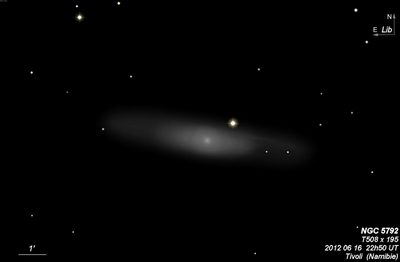
William Herschel discovered NGC 5792 = H II-683 on 11 Apr 1787 (sweep 727) and recorded "pB, pL, R, mbM, sf a considerable star; the nebulosity joining to it with a little nebulosity towards the following side." His position is accurate. Not observed by JH, but d'Arrest made two observations and seen twice at Birr Castle.
200/250mm - 8" (6/30/84): faint, elongated 5:2 ~E-W, very diffuse, even surface brightness. A mag 10 star is attached at the WNW side of the core 1.1' from center and interferes with viewing.
400/500mm - 17.5" (6/12/99): moderately bright, fairly large, broad concentration with a quasi-stellar nucleus at moments with direct vision. A mag 10 star close WNW of the core detracts from viewing. Initially appeared ~2.5'x1.5', but with averted vision, very low surface brightness extensions oriented E-W increase the dimensions to at least 4'x1.5'. The ends of the arms fade into the background so it was difficult to judge the size.
900/1200mm - 48" (5/16/12): very bright, very large, very elongated over 4:1 E-W, ~6.2'x1.5'. Dominated by a large, bright central region that increases to an intensely bright core. The central region has a patchy, dusty appearance in the outer portion. A mag 9.6 star is attached at the NW edge of the core. A single, thin spiral arm is attached near this star (slightly east) and shoots west for ~2.5', curving very little. There is no counterpart on the east side, but just a very large, elongated, low surface brightness halo that extends east for ~2' towards a mag 14 star.
Notes by Steve Gottlieb
NGC 5728
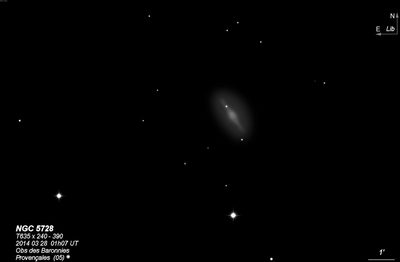
William Herschel discovered NGC 5728 = H I-184 = h1866 on 7 May 1787 (sweep 732) and recorded "cB, pL, E from sp to nf, mbM." His position is accurate. On his first observation, JH called this object "pB; mE; bM, almost to nucleus; has a * 10m 90° south." On a second sweep, he logged "F; R; pgbM; 20" has a * 15 nf; certainly not of first and hardly of second class. Sky perfectly clear."
300/350mm - 13.1" (6/18/85): moderately bright, very elongated 3:1 SSW-NNE. Contains a bright core and possible stellar nucleus. A faint mag 14.5 star is at the southern tip 1.2' from center. An extremely faint 15th magnitude star is suspected just north of the core 0.4' from center. NGC 5716 lies 23' SW.
Notes by Steve Gottlieb
NGC 5861
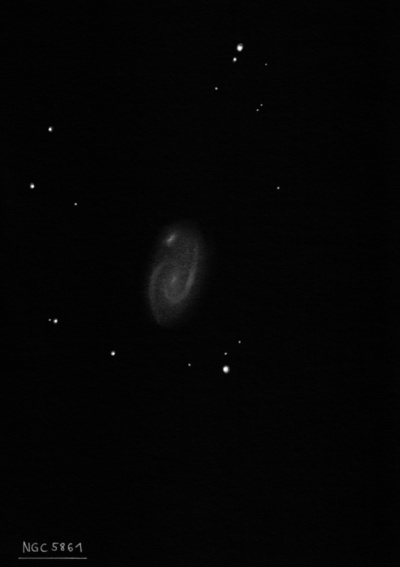
William Herschel discovered NGC 5861 = H II-192 on 9 May 1784 (sweep 210) and recorded "Faintish, pL and broad, lE, r, nearly of equal brightness throughout; the extension almost in the meridian; many stars in the field with it." His position was 2.5' too far northwest.
300/350mm - 13.1" (7/5/83): fairly large, very diffuse, elongated 3:2 NW-SE, fairly low even surface brightness. Located 2.5' NNE of a mag 10.5 star. Forms a pair with NGC 5858 9.5' NW.
600/800mm - 24" (6/21 and 6/22/17): at 375x; moderately to fairly bright, fairly large, oval 5:3 NNW-SSE, ~2.0'x1.2', broad weak concentration, slightly brighter core/nucleus. The halo exhibited evidence of spiral structure with slightly brighter and darker regions. Last in a collinear trio with NGC 5858 9.5' NW and IC 1091 19' NW.
Supernova 2017erp, discovered 8 days earlier on 13 Jun, was easily visible as a mag 13.5-14 stellar object on the SSW edge of the halo.
Notes by Steve Gottlieb
NGC 5915
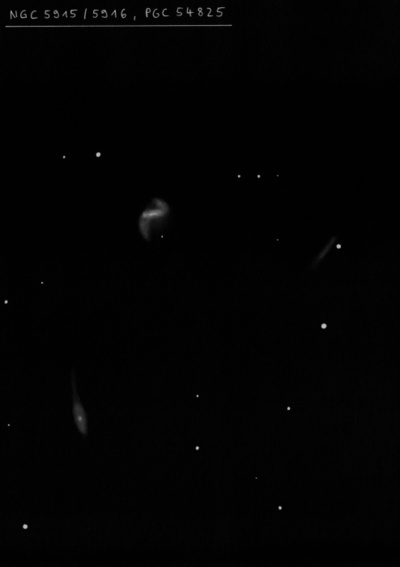
John Herschel discovered NGC 5915 = h3600, along with NGC 5916, on 5 Jun 1836 and recorded "B; S; R; glbM; 15". The preceding of 2." His position is accurate.
300/350mm - 13" (6/4/83): fairly faint, small, fairly compact, round, slightly brighter core.
400/500mm - 17.5" (5/30/92): fairly faint, fairly small, elongated 3:2 NW-SE, 1.0'x0.7', brighter along the major axis but halo appears rounder. A mag 15 star is at the south edge 33" from center and a mag 12.5 star is 2.1' NE. Forms a pair with NGC 5916 4.5' SSE.
Notes by Steve Gottlieb
NGC 5917
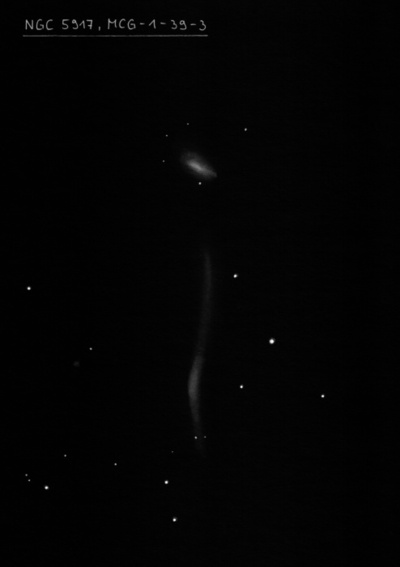
MCG -01-39-003 (nicknamed the "Hooked Galaxy") appeared faint, small, slightly elongated, weak concentration. A mag 10 star is 1.8' ESE. On deep images MCG -01-39-003 has two tidal tails, with a long one stretching north about 2/3 of the way to NGC 5917 and then hooking east at the end.
John Herschel discovered NGC 5917 = h3602 on 16 Jul 1835 and recorded "eF; S; psbM; 10"." His single position is 1' too far north.
Supernova SN 2005cf exploded in the vicinity of the bridge connecting NGC 5917 and MCG -01-39-003 in May 2005.
400/500mm - 17.5" (7/9/94): moderately bright, fairly small, elongated 3:2 WSW-ENE, brighter along the major axis. A mag 15 star is just off the SW edge. Forms an interacting pair (Arp 254) with MCG -01-39-003 4.2' S. Located 4' NNE of a mag 10 star.
Notes by Steve Gottlieb